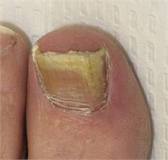Posts Tagged ‘fungal toenail infection’
So How Do I Tell if My Toenail is Infected With a Fungus?
So How Do I Tell if My Toenail
is Infected With a Fungus?
 Having a nail that is infected with a fungus is not all that uncommon as it affects 10-12% of the American population. A toenail fungal infection is caused by microorganisms that lodge in the tiny cracks in the skin around the toenails. As the foot usually lives in a dark, damp environment, this is an ideal growing medium for the fungal spores. The symptoms of a fungal toenail infection are fairly consistent and if you know what to look for it is easier to catch it early on.
Having a nail that is infected with a fungus is not all that uncommon as it affects 10-12% of the American population. A toenail fungal infection is caused by microorganisms that lodge in the tiny cracks in the skin around the toenails. As the foot usually lives in a dark, damp environment, this is an ideal growing medium for the fungal spores. The symptoms of a fungal toenail infection are fairly consistent and if you know what to look for it is easier to catch it early on.
The first symptom to show up is usually a white or yellowish spot on the toenail. This may be a minute object, which makes it harder to recognize. This spot is the beginnings of the infection and will gradually grow to cover more of the nail. As most people don’t suffer any discomfort and with the advent of wearing nail polish, many people don’t even notice this minor change.
As the infection continues, the small spot will increase and cover the entire toenail. The toenail will become dull, yellowed and even change shape. Some people see a dark spot either where the infection began or around the edges of the toenail, though this happens more frequently with severe cases. At some point, the nail may become disconnected from the nail bed.
Nail becoming yellow and thick?
The process of the nail becoming yellow and thick is a classic toenail fungus symptom. Also common is flaking or crumbling of the toenail, which again occurs in the severe cases of the disease.
The only way to determine whether your symptoms are that of a toenail fungal infection or are the result of something that mimics these symptoms is to see your doctor. At that point your doctor will be able to ask you some questions and take a sample of your toenail to be examined under a microscope and/or cultured. Be sure to tell your doctor if you have spent time in a public pool or spa lately as this may increase your chances of contracting a toenail fungus infection.
Ask the doctor
Once your doctor has been given the chance to examine and sample your toenail, a solution will be able to be found that will be most effective for you. This will help your doctor determine which medication will be best for your particular infection. Toenail funguses are notoriously difficult to treat and cure, so allowing your doctor to get all the pertinent information will help you both to make an informed decision. One of the problems with nail funguses is that they all tend to display the same symptoms but that doesn’t mean they require the same treatment. And there are other conditions that will mimic the standard symptoms of a nail fungus, so working with your doctor to come up with the best treatment is in everybody’s interest.